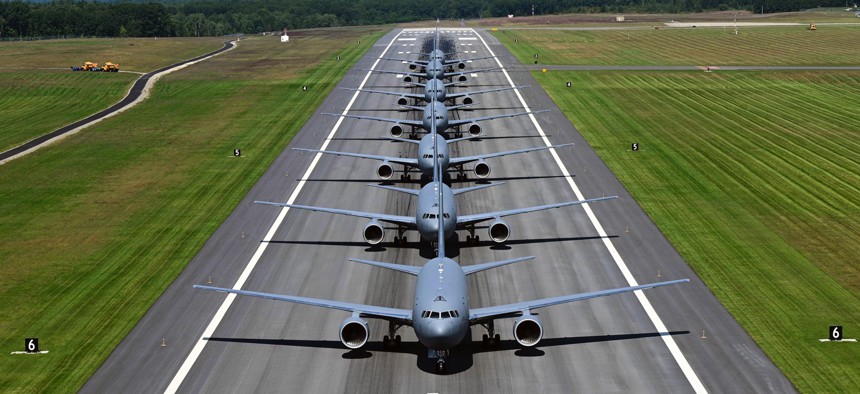
KC-46 Pegasus from Pease Air National Guard Base, N.H., participate in an elephant walk, Sept. 8, 2021. U.S. Air Force / Staff Sgt. Victoria Nelson
USAF walks back tanker forecast: ‘We don’t know what our strategy is’
As Boeing KC-46 deliveries resume, officials mull how many more—if any—to order.
DAYTON, Ohio—Several months after the Air Force’s top weapons buyer said the service would likely buy 75 additional KC-46 tankers, the service’s deputy program manager for mobility aircraft says not so fast.
It “doesn't matter what any person—senior leader or otherwise—has said. We don't know what our acquisition strategy is,” Scott Boyd said Monday at the Life Cycle Industry Days conference here. He said the service will likely settle on a plan by next June.
The Air Force needs more tankers to serve the fleet until its next-gen aerial refueler, or NGAS, arrives in the middle of next decade. But just how many depends on the murky question of when NGAS will actually arrive.
“If we ended up getting 2035 wrong, then perhaps we got the quantity of what we needed wrong. That's everyone's concern: the Air Force has that same concern, Congress has that concern, industry certainly has that concern,” Boyd said.
Lockheed Martin, in fact, is betting that NGAS will arrive late, and that the Air Force will wind up purchasing more than 75 tankers for the so-called “bridge buy.” Lockheed and Airbus are developing their own bridge-tanker offering, called LMXT. They’d need to sell at least 110 of the aircraft since the companies will need to set up assembly lines in the United States, Greg Ulmer, executive vice president of Lockheed’s Aeronautics business has told Defense One.
Boyd disagreed with Lockheed’s assessment that the next-gen refueler will be late, and said that while the service is still generating the requirements for NGAS, it will be “possible to field something as early as 2035 that meets that general vision,” he said.
The next tanker buy could be “potentially satisfied by the KC-46, but we still have to do our due diligence. It's always been that way. I've honestly not felt pressure from Congress or from within the Air Force to do anything different than what we were already doing,” Boyd said.
The service will release a request for information in September for the next tanker purchase, and use that information to determine the acquisition strategy, he said.
As the Air Force weighs what path to take for its next order of tankers, Boeing’s KC-46 program continues to be plagued with a myriad of developmental problems, including hiccups with the plane’s Remote Vision System, which allows the boom operator to see the boom through a video feed. The upgraded refueling camera system, RVS 2.0, is set to arrive in October 2025.
The program also has unresolved problems with a “stiff boom,” so the tanker is still not cleared to refuel A-10s. The camera system and boom stiffness are just two of the six “category one deficiencies” the program has, said Col. Leigh Ottati, chief of the KC-46 program office. The Pentagon labels a shortfall as “category one” if it could cause loss or damage to the aircraft or even death, among other problems.
Boeing’s losses on the tanker program already top $7 billion, and Ottati couldn’t say if resolving the remaining deficiencies will incur even more charges for Boeing in the future.
“I know that I will hold them to their agreement on what they agreed to do as far as fixing RVS 2.0 and the other [category] one deficiencies, but I don't know if they’ve booked those losses already or if they're going to book them in the future,” Ottati said.
Deliveries of KC-46s resumed last week after being on hold since March due to a problem with the aircraft’s fuel tanks, Ottati said. The hold has caused Ottati’s office to fail to meet their commitment to Air Mobility Command, he said.
“It's had an impact on our ability to deliver on what was expected for the year. But we'll see what they can deliver in the remainder of this quarter and then the last quarter of the year as well,” Ottati said.




